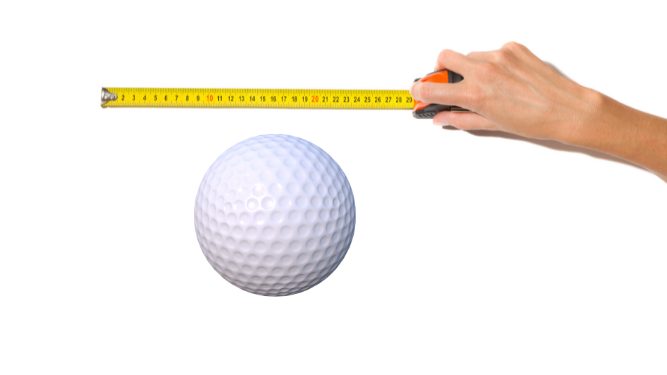Golf balls don’t come in a wide range of shapes and sizes. Unlike golf clubs, they are always small and round with a dull, white appearance. However, this does not imply that all balls are created equal, as they vary in weight, cover, and, most importantly, size. The differences may appear minor on paper, but they significantly impact your play golf course.
So, you’re here because you’re wondering, how many centimeters is a golf ball? How does it affect your shot? I have put together this handy guide that will explain everything you need to know about the size of a golf ball.
Average Golf Ball Size
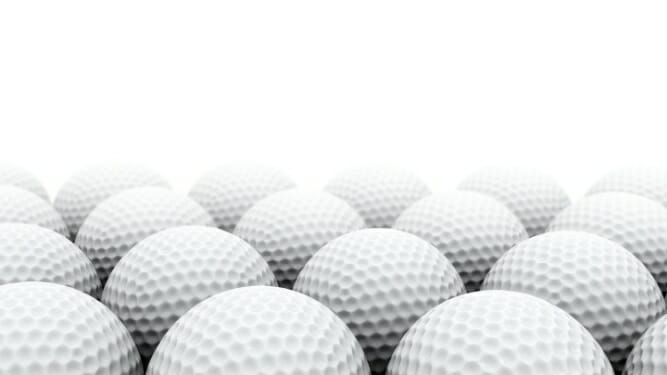
An official golf ball diameter must not be less than 1.68 inches. It is equivalent to 4.268 cm or 42.68 mm. It must be at a maximum ounce weight of 1.62 oz. 45.93 grams. The USGA for America and the British R&A, which governs golf in Scotland and England, have approved these standards. It’s the universal and ideal golf ball size because that specific weight and diameter combination provides you the best velocity and distance while also having a moderately high spin rate.
Any golf ball that’s larger or heavier than this diameter or weight is considered illegal and a violation of the USGA golf ball regulations. The open tournament competitions will disqualify golfers who use these golf balls.
Do All Golf Balls Have Equal Sizes?
That question’s answer will be a yes and a no.
For recreational or casual games, you can use golf balls of different sizes. It could be smaller or larger, and it depends on what ball size suits your playing style. Also, before the 1980s, larger golf balls were more common, so it’s already not unheard of that some people use different golf ball sizes.
In contrast, if you’re a professional golfer, you should use the legal standard that the golfing community has agreed on for professional tournaments. So, to be used in professional competitions, you should use the ball with the specified size, or else you’ll not be able to play according to rules.
History of How Golf Ball Size Changed
In the United States, the official golf ball size used in competitions has remained relatively constant. The USGA, the governing body that oversees golf tournaments, has always used a golf ball diameter of 1.68 inches.
However, in Europe, things were a bit different. During the 1980s, the British Open Championship, one of the world’s oldest and most prestigious golfing competitions, allowed players to use a smaller golf ball. As a result, when the R&A, the British golf governing body, permitted the 1.62-inch ball, it was not challenged.
Although the USGA prohibited alternate balls, American players competing in the British Open could use a smaller ball. Many of the game’s greatest players, including Jack Nicklaus and Arnold Palmer, shifted to the smaller ball, also known as the British ball.
For years, the two balls were a source of contention among both countries’ golfing communities. Neither country recognized a single golf ball for international competitions until 1990. It was the year that the world’s golfing communities finally agreed that the minimum size of a golf ball for all competitions should be 1.68 inches. The USGA and R&A collaborated to establish the golf ball diameter and weight we all use today. The golf ball remained the same for over 30 years, with a minimum ounce weight of 1.62 and a diameter of 1.68 inches.
Average Golf Ball Size (cm)
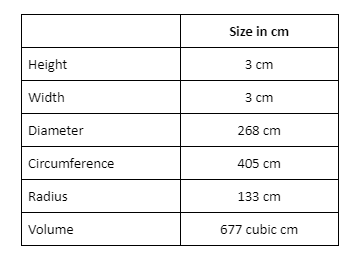
Bonus: Average Golf Ball Size (mm and inch)
For additional information, here are the sizes of golf balls in millimeters (mm) and inches (inch):
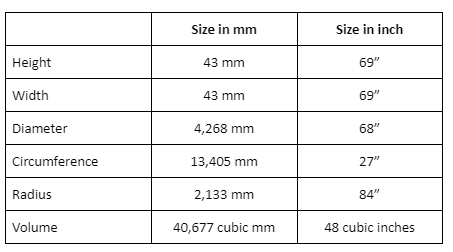
Golf Ball Dimples Size
Dimples are an essential component of golf ball design because they significantly influence the amount of lift and drag on your golf ball’s trajectory. A typical golf ball has 336 dimples with a depth of 0.01 inches on average. However, the number of dimples on each ball is not the same. Most golf balls have a dimple count of 250 to 500. When English engineer and manufacturer William Taylor filed a patent for a simple design in 1905, it became a feature of golf balls.
In general, the more dimples your ball has, the higher it will fly. It may appear to be a positive thing, but the greater the height your ball launches into the air, the shorter the distance it will travel. That is why 336 dimples are so common, as it creates an ideal balance of your shot distance and height.
Golf Ball Weight
A standard golf ball weighs 1.620 ounces / 45.93 grams / 0.101 pounds / 0.0459 kilograms. It is the maximum weight your golf ball can have when competing in a tournament. As a result, most golf balls in the market are around 46 grams in weight. This weight is the ideal weight that is neither too light nor too heavy.
Regulations of Golf Ball Size
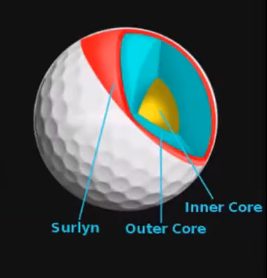
Golf balls have advanced significantly over the years, becoming highly sophisticated plastic and rubber balls. However, greater design advancements have resulted in stricter regulatory requirements. The PGA and USGA golf ball regulations have nearly identical conditions:
Shape
The ball must possess the fundamental properties of a spherically symmetrical ball. This means that it must be spherical and have a symmetrical arrangement of dimples on its surface.
Size
The golf ball’s maximum diameter is 1.68 inches (42.67 mm). The ball is about 2.5 times the width of the cup, thanks to the 4.25-inch hole. Golfers use this size because it provides the ideal weight and diameter for maximum distance when combined with USGA weight standards.
Weight
The weight of a golf ball cannot be less than 45.93 grams or greater than 1.62 ounces. These standards are consistent across all professional competitions, including open championships, to ensure that all golfers use the same minimum ball measurements.
Guide to Choose the Best Golf Ball Size for You
Golf balls are available in various sizes, firmness, and compression values. And selecting the best ball can be difficult. To help you choose the best one for you, here is the following information:

Beginner Level
There’s nothing wrong with using a beginner’s golf ball if you’re new to the game. These balls can boost a beginner’s confidence while showcasing why millions of people enjoy golf. Beginner golf balls travel shorter distances but have lower compression, allowing a more accurate shot. So, if your swing speed is 85mph or less, you should use a low compression ball. It’ll still travel a reasonable distance, providing a more controllable flight. However, if you’re having trouble finding the sweet spot, you can always choose a larger-sized golf ball or use a larger golf club. (1)
Here are the low compression balls I recommend for you:
Intermediate Level
If you are playing golf for a while, you’ll know that the options for golf balls are virtually limitless. The best ball for you will be determined by how quickly you swing at it. I always suggest a mid-compression ball to the average golfer. If you’re unsure which ball to get, this type will most likely suit your playing style. If you swing at speeds ranging from 86 to 105 mph, you are close to the mean. You should be good with a medium compression ball.
Wrapping Up
Knowing how many centimeters is a golf ball is very significant as a golfer. As I have mentioned, golf balls don’t have equal sizes, and you can use them depending on the situation. If you’re just a casual golfer, you could use a golf ball with a small or large size. It depends on your playing style so find out which ball size best suits you. However, if you’re a professional golfer, you should use the standard legal golf ball size for professional tournaments. It would be best to always practice with the average size to perform well and legally in professional competitions. (2)
That said, whether you are a professional golfer or just a casual one, determining how many cm in a golf ball is crucial as it directly affects your golf ball’s trajectory. With that knowledge and enough practice, you’ll have the most accurate shot and controllable flight possible.
Before we ned, you may want to check other learning and product guides. Make sure to bookmark them for your future references! Until our next article!
References
(1) compression – https://www.britannica.com/science/compression
(2) professional – https://www.techrepublic.com/blog/10-things/10-things-that-define-a-true-professional/

